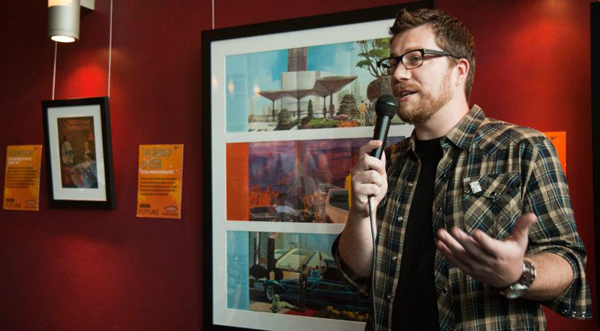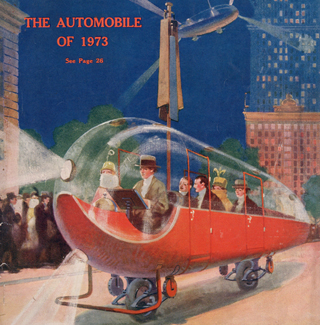
When blogger Matt Novak interviewed the late science fiction author Ray Bradbury earlier this year, he was surprised to learn that the 91-year-old – whose most famous novel described a future society that outlawed books – detested the notion of e-books.
“He just couldn’t wrap his head around it,” says Novak, himself the writer of a retro-future blog that’s getting a lot of attention. “They were not real books to him.”
Novak is fascinated by perceptions and time. His blog, Paleofutures, which he created five years ago as a writing assignment in a UWM class, focuses on past visions of the future over a span of 13 decades, beginning with the 1870s. It discusses the many ways our ancestors thought the world of tomorrow would be different from today.

The blog was recently picked up by Smithsonian Magazine. Novak also writes columns for the BBC Future and The Daily on similar topics, allowing him to quit his day job at a Minneapolis marketing firm and become a full-time writer and archivist. But even in its obscure first two weeks in cyberspace in 2007, his blog attracted 30,000 hits.
“No one was covering this topic and that’s precisely why it took off,” Novak says. “People were interested and there wasn’t much about it already online.”
Not just oddities
Along with sharing fantastic visions like flying cars and vacation homes on the moon, Novak puts the imagined ideas and inventions that appeared in popular culture into historical context, looking beneath their utopian idealism.
“When I do a topic, like late 19th century feminism, there’s something in how these ideas naturally flowed from their generations,” he says. “Like the ‘meal in a pill.’ The reason it stirred the imagination is it would have freed women from spending the entire day in the kitchen preparing food.”
The appeal of retro-futurism, says Novak, is what it tells us about our past selves. “It offers us a barometer for measuring every generation’s greatest aspirations and deepest fears,” he says.
What life’s about
Though he has always been interested in history and futurism, Novak didn’t put the two together until he took a blogging class at UWM and had to come up with a subject.
“I didn’t want to write about something personal. At the time, I was into old comedy records and I thought about that as a topic. But I also thought of futurism and I wasn’t finding anything like that on the Web.”
Originally from the Minneapolis area, Novak transferred to UWM from UW-River Falls so he could be closer to his girlfriend in Chicago. He left after starting the blog to take a job offer in Minneapolis. But it was without his degree – he’s only one course away from a bachelor’s in journalism.
While working 60- to 70-hour weeks, Novak continued to plug away at his blog without pay. “It was exhausting and sometimes I really did not want to do it. But I found something that I’m passionate about and I think that’s what life is all about.”
Before Smithsonian acquired the blog, it was already touted by a list of media, including the London Times, Canadian National Post, Boston Globe, Utne Reader and, earlier this year, Forbes.
A ‘dead-tree’ library
Because so little of this information is available on the Internet, Novak relies on old-school print sources – what he calls his “dead-tree” collection: books, magazines, comics, newspaper clippings, artwork and other memorabilia. And the collection is vast. Parts were on display in Hollywood in April, an exhibit sponsored by BBC Future.
He also borrows from the collections of others. Brian Horrigan, exhibits curator for the Minnesota Historical Society, gave his file of personal correspondence with geodesic dome pioneer R. Buckminster Fuller to Novak.
Running out of material has never worried Novak. “I haven’t cracked the year 2000 in the blog yet,” he says.
Crazy optimism
When asked to name a favorite resource, Novak names a comic strip by well-known commercial artist Arthur Radebaugh that appeared in newspapers from 1958 to ’62. The strip, “Closer Than We Think!,” showcased amazing illustrations of future technologies, like jetpack-equipped mail carriers hopping from house to house along their routes.
“That is my favorite time in history, too,” he says. “It was a crazy optimistic time with the most outlandish technology predictions, even though it was tempered by the Soviet superiority in the space race.”
While the romanticizing was fun and hopeful, Novak says, many predictions were rooted in the hope for panaceas and became a source of disappointment when they didn’t materialize.
In fact, Novak doesn’t believe in the exponential growth of technology.
“The more I look at technology over the decades, the more I see that the really big changes – the ones that changed us forever, like the telegraph or flight – don’t come along as often as people think,” he says. “It blows my mind to think of what it would have been like, for example, to live without electricity!”






